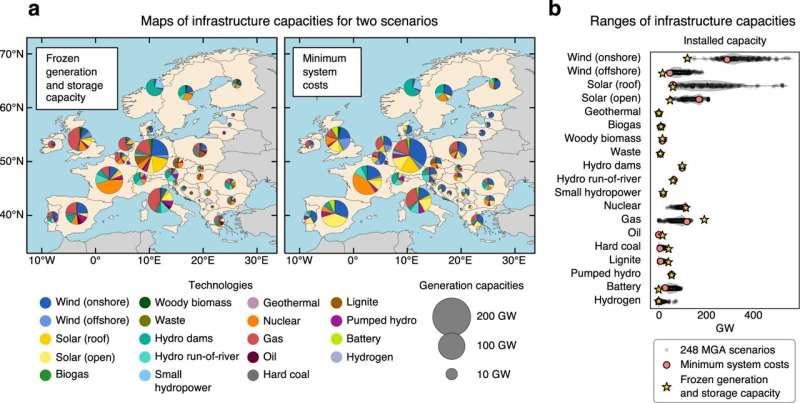Analyzed scenarios of electricity system infrastructure in 2035. a Maps of electricity generation and storage capacities for the scenario of frozen generation and storage capacity and the scenario of minimum system costs. The frozen scenario assumes that generation and storage capacities of 2035 are as in 2018, but that transmission capacities can increase to accommodate the higher electricity demand of 2035. The scenario of minimum system costs is found through optimization. For visualization purposes, installed capacities are shown at country-level instead of NUTS-2 level. Background maps: Made with Natural Earth. Detailed maps of installed capacities at grid node level are shown in Supplementary Fig. 1. b Ranges of electricity generation and storage capacities for 248 MGA scenarios in 2035 and the two scenarios: frozen generation and storage capacity, and minimum system costs. Violin plots show the range of capacities for 248 MGA scenarios. MGA scenarios have up to 20% higher total system costs than the minimum cost scenario (see Methods). MGA scenarios are exploratory and do not define national policy targets, subsidies, or taxes. Software to reproduce this figure can be found on Zenodo55. MGA Modeling to Generate Alternatives. Credit: Nature Communications (2023). DOI: 10.1038/s41467-023-37946-3
Greenhouse gas reduction, new jobs, new investment opportunities: the benefits of decarbonizing the electricity sector—one of the most polluting—are obvious. However, a transition to lower-carbon electricity production could have a negative impact on some regions, depending on their vulnerabilities and their capacity to adapt, while it could have a positive impact on others.
A team from the University of Geneva (UNIGE) has precisely mapped the socio-economic consequences of electricity decarbonization for 296 regions in Europe by 2050. It shows that the southern and south-eastern regions of the continent could be the most vulnerable. These results can be found in Nature Communications.
The electricity consumed in Europe is largely produced by highly polluting fossil fuel power plants (coal, gas). This sector alone is responsible for a quarter of the continent's greenhouse gas (GHG) emissions. Decarbonizing electricity has therefore become a priority. It is also a prerequisite for the decarbonization of other sectors that need to be electrified, such as heating and transport.
The benefits of such a transition are obvious (reduced air pollution, new employment opportunities). However, the process could also maintain or lead to some new inequalities between regions. For example, an area with a coal-fired power plant will lose many jobs and tax revenues if the plant closes. It will be doubly penalized if there is little land available to build new renewable energy plants.
Impact of 248 scenarios assessed
Data on the regional consequences of decarbonized electricity are still lacking. To remedy this, a team from the University of Geneva (UNIGE) has analyzed the socio-economic impacts of 248 electricity transition scenarios on 296 regions in Europe. These regions correspond to the NUTS 2 level of the Nomenclature of Territorial Units for Statistics (NUTS) defined by the EU, which divides the European Economic Area into areas of 800,000 to 3 million inhabitants.
"To simulate the different scenarios, we took into account all existing means of electricity production for each region, such as nuclear, hydro, photovoltaic, wind and fossil fuels, as well as electricity transmission and storage. We studied their possible configurations in 2035 to be on the way to achieve net-zero greenhouse gas emissions in 2050," explains Jan-Philipp Sasse, a former post-doctoral scholar in the Renewable Energy Systems Group at the UNIGE's Institute of Environmental Sciences (ISE) and the study's first author.
Vulnerability criteria were selected for each region, such as air pollution, the price of electricity, the nature of employment, the amount of land available or the new investments that this transition could or could not generate. The amount of electricity consumed, produced, imported and exported locally every 6 hours for a year was also taken into account. Processed by a high-performance computer cluster—a grouping of several state-of-the-art computers—these data were used to model the different scenarios and their impact.
North-South divide
"Our results show that the benefits of a transition to net-zero greenhouse gas emissions in 2050 would be tangible already by 2035. In terms of air quality, investment and job creation, these benefits tend to be concentrated in the richer regions of northern Europe. Those in southern and south-eastern Europe are generally more vulnerable," says Evelina Trutnevyte, head of the Renewable Energy Systems Group at the Institute of Environmental Sciences (ISE) and associate professor in the Section of Earth and Environmental Sciences at the UNIGE's Faculty of Science, co-author of the study.
For example, North Jutland in Denmark would benefit from additional investment—and thus jobs—related to offshore wind installations. Sicily and Campania, on the other hand, would experience an increase in electricity prices. Due to their geographical location, these two Italian regions would not be able to import electricity freely and flexibly from other European regions, where it is cheaper. "In Switzerland, the impact of this transition would be almost neutral because the country has no fossil fuel power plants to close and the other vulnerabilities and benefits are balanced."
Based on these results, the scientists created benefit and vulnerability indices for the different scenarios. These data can now be integrated into energy transition strategies in the electricity sector. They are a tool for a European coordination of a fair and equitable energy transition including measures to compensate for regional inequalities.
More information: Jan-Philipp Sasse et al, A low-carbon electricity sector in Europe risks sustaining regional inequalities in benefits and vulnerabilities, Nature Communications (2023). DOI: 10.1038/s41467-023-37946-3
Journal information: Nature Communications
Provided by University of Geneva
























